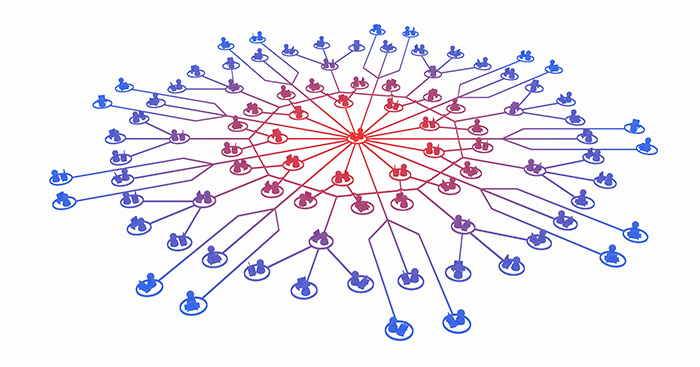Are you looking to make big profits with the help of traffic sources in Affiliate Marketing?! The awesome marketing team from Ampry, a favorite conversion platform of affiliates, shared some thoughts on the best sources.
Before you start, it is essential to first get familiar with each traffic source and weigh out their pros and cons. In addition, you must clearly understand the features and statistics they offer – and which ones you’ll need to pay the most attention to.
Ready to make some money? Let’s jump in!

What is a Traffic Source?
Are you a Webmaster or a Media Buyer?
If you are a Webmaster, a traffic source for you is the chosen platform through which users find your website. Every time someone visits your website, you can trace their origin to where they came from.
But, what if you’re a Media Buyer?
As a Media Buyer, traffic sources consist of the place (or platform) where you can purchase traffic from.
By simply educating yourself on exactly which traffic sources are yielding the most profits, you can more clearly adjust and shape your SEO, SEM, SMO, and overall business monetization strategy.
The Affiliate Marketing Game: What Aspects Should You Consider Before Selecting a Traffic Source?
Because there are numerous aspects to be considered when choosing a traffic source, we will list the most important ones to keep in mind:
- The Niche or Target Audience
- The Overall Quality Offered by the Traffic Source
- Rules, Regulations, and Restrictions
- The Cost of the Traffic Source
- The Amount of Traffic Available from the Traffic Source
- The Targeting Options that are Available
Now, let’s expand on these aspects.

The Niche or Target Audience
The right niche is incredibly important. But why?
The only way to understand a particular affiliate marketing vertical to a “T,” is by focusing on a niche and learning everything there is to know about it. From there, you’ll be able to easily work with the offer types of your specific niche.
Expert Tip: The affiliate marketing game is all about information. You’ll see a lot more success if you specify yourself and become fully acquainted with your particular vertical of choice.
With that considered, you must check everything around a specific traffic source before jumping in to use it.
The Overall Quality Offered From The Traffic Source
When determining the overall quality of a traffic source, there are two things you need to keep in mind:
- The fact that some networks just have low traffic quality (even though the traffic is not bot traffic)
- The fact that there is a lot of bot traffic out there
The ultimate plague in affiliate marketing – known as affiliate fraud – has caused a serious impact on internet traffic sources. The clicks or site visits received are fraudulently generated from a click farm aren’t real people. Affiliate fraud can cause major money loss and generate inaccurate reports.
Picture this: A well-known traffic source is rumored to be teaming with fraudulent traffic. Would you still choose to work with that traffic source?
Probably not.
Another example of fraudulent shenanigans within the affiliate marketing realm?
Owners of shady networks can simulate conversions, causing a reflection of fake quality. This works because it gives the affiliate community a false appearance of offer success. Some people become enticed and bet like crazy on that networks with apparent offer success.
The moral of this story? The more real traffic a network provides, the more quality the traffic will be. The result? Higher ranks within the minds and hearts of affiliates. Make sure you are only playing with credible traffic sources with a clean reputation in the market.
Rules, Regulations, and Restrictions
Some traffic sources for websites have tough restrictions that you should keep an eye out for. Watch for misleading banners that don’t follow guidelines and regulations. Take the extra time to read the restrictions of each traffic source carefully. Otherwise, you may get banned for breaking the rules.
Another point to consider – what type of content are you planning to promote?
For example: If you are planning to promote adult content on a very mainstream ad network, your campaigns may not get approved!
The Cost of the Traffic Source
There’s one thing you can count on: Every traffic source has a certain cost. This cost is based on its type of traffic, the number of GEOs you can monetize, the quality of traffic provided, etc.
This is where heavy amounts of research on various traffic sources will really pay off.
While some traffic sources promote having traffic that converts well, others may not showcase the same powerful converting stats. That said, due to incredibly tough competition, several traffic sites are very overpriced. On the other hand, some are cheap – and can actually help you make buckets full of cash.
Again, do your research.
The Amount of Traffic Available from the Traffic Source
The amount of potential traffic you could generate varies with each ad network. Just as it varies from vertical to vertical. Be wise when choosing a network with “a ton of traffic available!”.
In the marketing world, there are loads of networks that promote their ‘outpour’ of available traffic. Even if that is the case, the quality of said traffic is often extremely low!
So, take the offer you’re planning to promote into view. From there, decide where to buy traffic based on which volumes you’re offer/product would best flourish in.
The Targeting Options that are Available
I think we can all agree: Targeting is a super valuable tool in this industry.
Targeting allows you to choose exactly which specific aspects of your campaign should be targeted.
Here are some common examples of targeting options:
- GEO
- Gender
- Age
- Operators
- Time of Day
- Specific Browsers
- Operating Systems (iOS vs. Android)
- Devices (Desktop vs. Mobile)
- Websites
- Categories
- Languages
- Traffic Sources, etc.
Some traffic sources provide limitations as to exactly what/who you can target. Always review the features and restrictions associated with a specific traffic source before diving in.
Expert Tip: As if you don’t already know by now, targeting is HUGE! With the ability to decide who should see your ads, you’re basically picking a select pool of users you KNOW will be interested in your service/product. Which, of course, will lead to more sales. It’s all about the money in affiliate marketing, am I right?!
Get ready to see your conversions shoot out of the roof!

Best Traffic Sources for Affiliate Marketing in 2020
Now that you know what to look for when selecting a traffic source, it’s time to become an expert in the best traffic sources for affiliate marketing!
Firstly, it is important to realize that there are myriads of traffic sources out there. Due to that fact, I’ve taken the opportunity to categorize each one into separate tiers.
Here’s the full list of category types for affiliate marketing traffic sources:
- Mainstream Traffic
- Native Ads
- URL Shortening Tools
- Search Traffic
- Mobile Traffic
- Social Traffic
- PPV Traffic (Pay-Per-View Traffic)
Now, let’s expand on these types of traffic sources for a better understanding of each!
Mainstream Traffic
The best way to describe Mainstream Traffic is to address that it is the type of traffic that can be seen by all the general population.
Mainstream traffic ads consist of “PG-13” rated ads that no one would be offended by.
Due to their mild rating, these ads correspond to just about a billion offers you can work with. Here are a few great mainstream traffic verticals you could shoot for:
- Mobile Content
- Gambling
- Nutraceuticals
- Dating
- Travel
- eCommerce
- Finance
- Mainstream VOD
Native Ads
What are native ads, exactly?
They are a type of ad format that resembles the look and feel of whatever context they’re displayed in.
Think of a chameleon – these non-intrusive ads blend into a webpage, making them look less “ad-like” (for lack of a better word). Native ads can blend in with any website.
Native ads are certainly proving their worth in affiliate marketing, as the primary concern of any publisher is user retention, and Native Ads are less prone to being an annoying nuisance to users.
According to Business Insider, native Ads will be responsible for 74% of ALL ad revenue by the year 2021. Yes, you heard that right!
And for you publishers out there, native ads represent a retention rate that’s significantly higher than banner ads. In fact, these ads generate a retention rate that is three times as high, compared to banner ads.
Advertisers, where you at?! It’s important to know that native ads represent a spine-tingling engagement increase of approx. 60%.
So, what’s the game plan for optimization with native advertising? Simple. Purchase dirt-cheap CPCs and compete for site placements.
URL Shortening Tools
FACT: URL shortening is actually a very famous technique you can find online.
In short, it allows a URL to be made a lot shorter, while still providing the power to direct users to the page they’re looking for.
There are some online URL shortening tools, such as Google URL Shortener or Bit.ly. By using a shortened URL, publishers have the chance to make cold, hard cash based on the number of users who happen to visit the link. Once a user opens the link, they get a tasty treat – 5 seconds of an ad. From there, they can choose to skip the ad and get to the (now) shortened URL.
This process is often referred to as Interstitial Advertising and is a key tool for any marketer.
Search Traffic
When it comes to search traffic, there are two different types you should make yourself familiar with:
- Paid Ads or PPC
- Organic Traffic
Paid Ads directly correlate with Google Adwords, an advertising service created for businesses that want to display advertisements on Google.
Organic Traffic comes directly from the search engine. Organic traffic is also called unpaid traffic, just as paid traffic refers to traffic from a Google Ad or another advertising platform. Your conversion rate is seven times higher when you’re getting someone to directly visit your website or ad (Organic Traffic!). Keep this in mind when planning your ad campaign.
People have been using Google for decades. Google users are intelligent creatures who can tell an ad from organic search results. Users (or potential customers) respond to organic results as “official” or “proven” ads. It’s sort of like a digital seal of quality. When your product lands on page 1 of Google for a specific keyword, that basically translates to Google tapping you on the back and saying:
“Congrats! Your product rocks!”
As far as Adwords is concerned, your Cost Per Click (CPC) is determined by the keyword you’re bidding for, and just how relevant your website and ad are to that specific keyword.
While Google is the most visited website on earth, there are other online traffic sources for search traffic out there. You could promote on Yahoo, Bing, Baidu, Gigablast, DuckDuckGo, etc.
Mobile Traffic
Believe it or not: Mobile traffic is currently the fastest-growing traffic source on earth.
So no, it is not a trend. It’s a full-blown epidemic!
Now is as good a time as any to start buying mobile traffic and raking in the money.
Facebook shares are showcasing a record high value. This surge in revenue is linked with a consistent dominance in the world of mobile video advertising. Another tech master – Google – has announced major revenue growth, all thanks to mobile ads. In fact, Google managed to make close to 50 billion dollars from mobile alone in 2017.
Expert Tip: Several web traffic sources offer both mobile and desktop traffic. Make sure to separate these two types because they convert differently. For example, it can be tough to make sure that your banner ad is being displayed correctly on all the different smartphone platforms out there. Even so, the mobile realm allows you to explore inexpensive ad spending with high return revenue potential.
Social Traffic
Social media ads are huge revenue builders!
Traffic sources such as LinkedIn, Twitter, Facebook, Snapchat, Instagram, and Pinterest are gaining serious money. Trust me: you want to be a part of it!
When it comes to social traffic, targeting is key. You could target based on location, demographics, age, interests, etc. Facebook has an incredible targeting algorithm and provides very detailed data on your return reports. With this tool, you can optimize based on what is shown on these reports.
To wrap up, social ads are a great way to ensure you are efficiently targeting your ads to be seen by the exact type of users/customers who most frequently purchase your service/products. In addition, since social media platforms like Facebook have literally billions of users, scaling up with social media marketing is quite easy!
PPV Traffic (Pay-Per-View Traffic)
PPV traffic stands for Pay-Per-View, this basically means that you pay an advertising network for every single time your ad or website is shown to a given user.
This traffic source is also known as CPV (Cost-Per-View). Not to be confused with PPC traffic sources, these traffic networks manage to install toolbars on a user’s computer.
So, why do these networks install toolbars on a user’s computer, exactly?
Because now, that network can effectively earn money by advertising pop-ups on those computer screens. The advertiser bids on a certain site, and when users reach that site, they’re warmly welcomed by an annoying, yet profitable, ad.
In addition, there is an opportunity for keyword targeting. Advertisers put money on a set of words, so when users type in that specific keyword, the ad will appear. This leads to more money in the pockets of the PPV network holders.
How Can I Start Promoting Ads on Traffic Sources?
Remember to select only one traffic source, for starters.
Select ad networks that have credibility in that market.
Don’t forget to add some cash into the ad network.
It will only work if you both get your money and pay when needed. This will be massively beneficial when the time to scale up comes around.
You must be able to collect enough data to help you perform strategic changes during the optimization process. Therefore, you must be willing to invest a decent amount of money towards your ads.
There are so many awesome internet traffic sources out there that can effectively help you promote and monetize your ads. However, it is essential to do your research and find a traffic source that will best promote your product/service.
Good luck!






